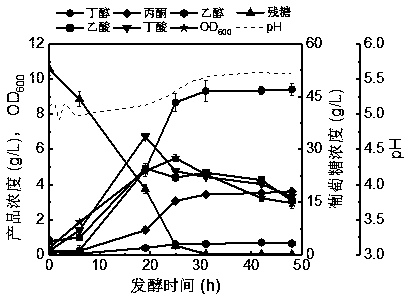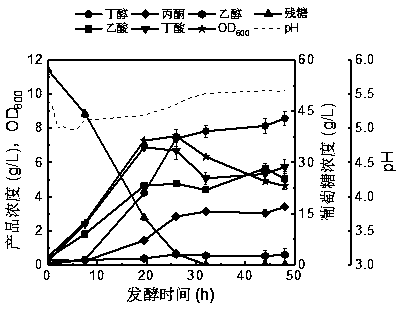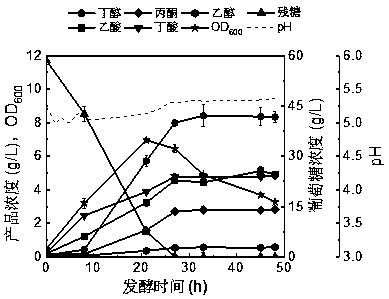Efficient synthesis of solvents and organic acids via butanol fermentation
A technology of butanol fermentation and organic acid, which is applied in the field of microbial fermentation, can solve the problems of low butyric acid concentration, low butyric acid/butanol, inability to obtain high value-added products of in-situ synthesis of butyl butyrate, and achieve high-efficiency synthesis , increase production and reduce the cost of fermentation raw materials
- Summary
- Abstract
- Description
- Claims
- Application Information
AI Technical Summary
Problems solved by technology
Method used
Image
Examples
Embodiment approach 2
[0039] Embodiment 2: Butanol fermentation process with 0.2 g / L vanillin added
[0040] The preparation process of the activation solution is exactly the same as that in Embodiment 1, and will not be repeated here.
[0041] The preparation process of the Clostridium acetobutylicum seed solution is exactly the same as that in Embodiment 1, and will not be repeated here.
[0042] The Clostridium acetobutylicum seed solution was transferred to a 5 L anaerobic fermentation tank with an inoculum of 10% (v / v), and the anaerobic fermentation tank was filled with 3 L Clostridium fermentation medium (where the glucose concentration was 60 g / L, the vanillin concentration is 0.2 g / L), the fermentation temperature is 37°C, and the pH control strategy during the fermentation process is expressed as follows: During the acid production period (~0-15 h), the pH is automatically controlled to 5.0 by the control cabinet , using 14% (w / v) ammonia water; during the solventogenic phase (~15-48 h)...
Embodiment approach 3
[0046] Embodiment 3: Butanol fermentation process with 0.2 g / L vanillic acid added
[0047] The preparation process of the activation solution is exactly the same as that in Embodiment 1, and will not be repeated here.
[0048] The preparation process of the Clostridium acetobutylicum seed solution is exactly the same as that in Embodiment 1, and will not be repeated here.
[0049] The Clostridium acetobutylicum seed solution was transferred to a 5 L anaerobic fermentation tank with an inoculum of 10% (v / v), and the anaerobic fermentation tank was filled with 3 L Clostridium fermentation medium (where the glucose concentration was 60 g / L, the concentration of vanillic acid is 0.2 g / L), the fermentation temperature is 37°C, and the pH control strategy during the fermentation process is expressed as follows: During the acid production period (~0-15 h), the pH is automatically controlled to 5.0 by the control cabinet, 14% (w / v) ammonia was utilized; during the solventogenic pha...
Embodiment approach 4
[0053] Embodiment 4: Butanol fermentation process with addition of 0.1 g / L vanillin and 0.1 g / L vanillic acid
[0054] The preparation process of the activation solution is exactly the same as that in Embodiment 1, and will not be repeated here.
[0055] The preparation process of the Clostridium acetobutylicum seed solution is exactly the same as that in Embodiment 1, and will not be repeated here.
[0056]The Clostridium acetobutylicum seed solution was transferred to a 5 L anaerobic fermentation tank with an inoculum of 10% (v / v), and the anaerobic fermentation tank was filled with 3 L Clostridium fermentation medium (where the glucose concentration was 60 g / L, the concentration of vanillin is 0.1 g / L, the concentration of vanillic acid is 0.1 g / L), the fermentation temperature is 37°C, and the pH control strategy during the fermentation process is expressed as follows: During the acid production period (~0-15 h) , the pH is automatically controlled to 5.0 through the con...
PUM
| Property | Measurement | Unit |
|---|---|---|
| wavelength | aaaaa | aaaaa |
Abstract
Description
Claims
Application Information
 Login to View More
Login to View More - R&D
- Intellectual Property
- Life Sciences
- Materials
- Tech Scout
- Unparalleled Data Quality
- Higher Quality Content
- 60% Fewer Hallucinations
Browse by: Latest US Patents, China's latest patents, Technical Efficacy Thesaurus, Application Domain, Technology Topic, Popular Technical Reports.
© 2025 PatSnap. All rights reserved.Legal|Privacy policy|Modern Slavery Act Transparency Statement|Sitemap|About US| Contact US: help@patsnap.com



